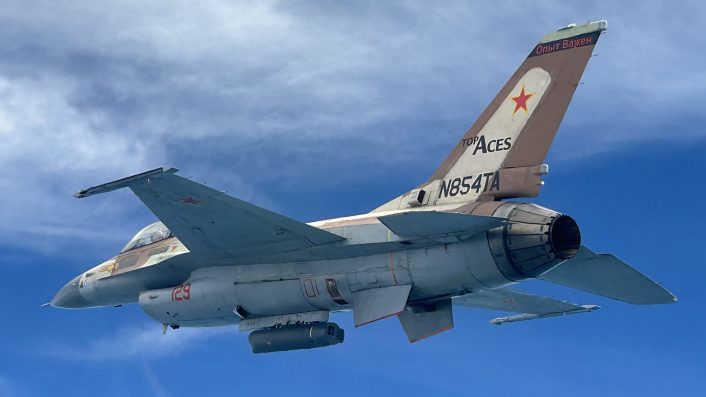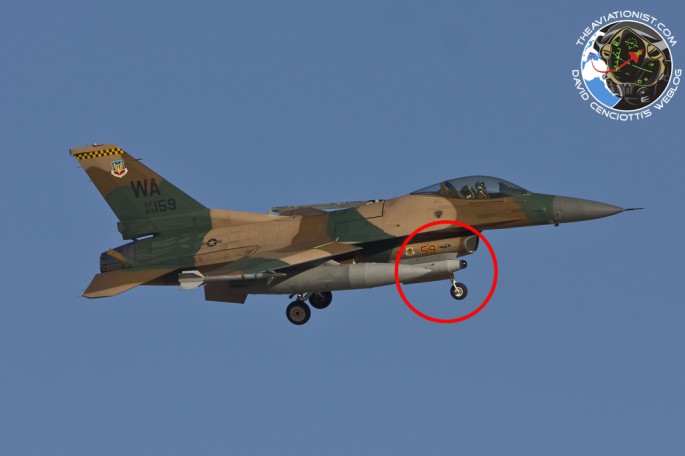The integration of the IRST pods will make the training experience of USAF 5th generation fighters even more realistic.
Top Aces Corp. is among the companies contracted under the Combat Air Forces (CAF) and Contracted Air Support (CAS) programs to enhance training at the U.S. Air Force’s Formal Training Units (FTU) and boost the number of new pilots being trained.
To fulfill this ADAIR (advanced adversary air) role, Top Aces uses former Israeli F-16A Netz (Hawk) aircraft, which were retired from the Israeli Air Force at the end of 2016. In 2021, Top Aces Corp. received its first batch of four F-16 Fighting Falcons from the Israeli Air Force, out of a total order of 29 aircraft. These jets, were delivered to the U.S. company with unspecified configurations and subsequently upgraded to a standard that is known as F-16 AAF (Advanced Aggressor Fighter).
The enhancements included the proprietary Advanced Aggressor Mission System (AAMS), which allows the F-16s to accurately replicate near-peer adversary fighters, enhancing training realism for U.S. pilots. This system, combined with AESA radars, Scorpion Helmet Mounted Displays, datalinks, and electronic countermeasures, provides a comprehensive suite of simulated advanced threats, although the aircraft operate in a clean configuration with simulated weapons only.
Interestingly, the Top Aces’ F-16s have now been equipped with IRST pods.
We’re thrilled to announce that we have integrated an infrared search and track (IRST) capability onto our F-16 Advanced Aggressor Fighter (AAF) platform!
This sophisticated technology will significantly elevate the training experience for @usairforce 5th generation fighter… pic.twitter.com/vKvmuU8Tk4
— Top Aces (@topaces) September 5, 2024
“We’re excited to enhance our ADAIR training capabilities with the addition of this advanced IRST technology,” said Russ Quinn, President of Top Aces Corp. and former USAF Aggressor pilot. “With our F-16 AAF platform fitted with the open-architecture AAMS, we can swiftly integrate new high-tech sensors to meet our customers’ evolving needs.”
Top Aces’ F-16 AAF now includes Northrop Grumman’s OpenPod equipped with Leonardo’s SkyWard IRST, enhancing long-range target detection and engagement. This setup allows pilots to integrate sensors seamlessly for advanced combat training.

Top Aces partnered with Leonardo, Northrop Grumman, CTSi, and Seger Aviation LLC to pioneer this IRST capability in the ADAIR sector.
“The Air Force requires capable adversaries for realistic training, and our F-16 AAF, coupled with experienced personnel, offers the most cost-effective and realistic solution to prepare future combat leaders,” Quinn added.
IRST
Infra-red search and track (IRST) systems are essential for countering stealth aircraft, which are designed to have minimal radar cross-section (RCS) and are nearly invisible to radar systems. However, these stealth planes still emit heat signatures, which can be detected by IRST systems.

The AN/AAS-42 targeting pod, carried by some U.S. aircraft like F-16s and F-15E Strike Eagles, as well as non-U.S. platforms such as the Eurofighter Typhoon, enables passive detection of enemy aircraft by focusing on their infrared emissions rather than radar signals.

Unlike radar, IRST does not actively emit signals, allowing aircraft to remain undetected while searching for targets. This technology, combined with advanced algorithms and data fusion, helps locate and track stealth aircraft by measuring the difference in the heat signature against the background. In combat scenarios, IRST systems can diminish the strategic advantages of stealth by providing an alternative detection method.
These capabilities are particularly useful against adversaries employing radar stealth technology, as IRST-equipped aircraft can approach undetected, using minimal radar or communication emissions, further reducing their own detectability. This approach of utilizing infrared systems and passive detection methods is increasingly relevant as stealth technology evolves, requiring new strategies for both defense and training. The integration of IRST pods on various types reflects the focus on replicating potential real-world threats, training pilots to counter modern challenges posed by advanced stealth aircraft.
In a broader tactical context, IRST systems are part of a comprehensive suite of sensors and strategies used to level the playing field against stealthy opponents. By utilizing IRST, pilots can maintain situational awareness and track targets that might otherwise evade detection. This sensor technology also supports engagements by providing targeting data for heat-seeking missiles, complementing other systems like radar and electronic warfare tools, and plays a crucial role in both offensive and defensive air combat operations.
The development and integration of these systems demonstrate an ongoing adaptation to emerging threats in modern air combat, ensuring that even stealth aircraft face significant challenges when engaging against forces equipped with advanced passive detection capabilities.
Top Aces
Thanks to the F-16, Top Aces is the first private company to operate 4th generation aircraft in contracted adversary air roles. These upgrades and capabilities are a significant leap from other private adversary aircraft like the Mirage F1, F-5 Tiger, A-4 Skyhawk, and Hawker Hunter, which, despite some upgrades, still face limitations due to their older designs and technologies. The performance and capabilities of the F-16s enable them to effectively simulate high-end threats, including 4th and 5th gen. enemy aircraft, which is critical for preparing U.S. pilots for future combat scenarios.
Top Aces initially received a contract in 2019 under the Combat Air Force/Contracted Air Support (CAF/CAS) program to provide realistic adversary air support, enhancing training for the U.S. Air Force’s Formal Training Units (FTUs). This contract aimed to improve the quality of pilot training by offering advanced adversary air and close air support scenarios. In 2022, Top Aces secured an additional contract to support training at Eglin AFB and Luke AFB, specifically targeting the development of F-22 and F-35 pilots, among others.
This contract underscores the strategic importance of Top Aces’ capabilities in preparing U.S. fighter pilots for a broad spectrum of potential combat situations, leveraging the advanced performance of their upgraded F-16 fleet.
With its fleet of upgraded F-16s, Top Aces plays a crucial role in enhancing the realism and effectiveness of air combat training for the U.S. Air Force, providing a versatile and robust platform to simulate a wide array of modern aerial threats. This not only improves pilot readiness but also helps address the growing demand for adversary air training amid evolving global security challenges. The integration of its F-16s with advanced training systems exemplifies the shift towards more sophisticated and adaptable private sector support in military training environments, marking a significant milestone in the evolution of contracted air support services.

